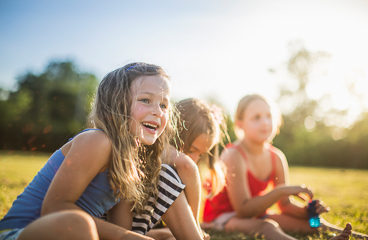Learning About Sun Damage and Your Child's Skin

How does the sun affect your child's skin?
Most kids love to play outdoors in the sun. It can be good for them. But getting too much of the ultraviolet (UV) rays in sunlight damages skin cells, which can lead to skin cancer later in life. And too much tanning, by the sun or from indoor tanning, can cause future wrinkles and discoloured skin.
People get most of their lifetime sun exposure in their first 18 years. Some of the damage done by UV rays during childhood might not appear for many years in the future. But you can help prevent it by protecting your child from the sun and teaching healthy habits now.
Age and skin type affect how easily your child becomes sunburned. A child's skin is more sensitive to sunlight. And the lighter your child's skin is, the more easily it can be damaged by the sun. But everyone can benefit from protecting their skin from the sun, regardless of skin colour.
The amount of skin damage your child can get from sunlight depends on:
- The time of day. Your child is more likely to get a sunburn in the middle of the day when the sun is most intense. You might think that exposure to the sun isn't a problem on cloudy days, but the sun's UV rays can still pass through clouds.
- Whether your child is near reflective surfaces, such as water, white sand, concrete, snow, or ice. All of these reflect the sun's UV rays.
- The season of the year. The intense sunlight of summer days can cause more damage than the sunlight in other seasons.
- Altitude. It's easy to get sunburned at higher altitudes. That's because there's less of the earth's atmosphere to block the sunlight. UV exposure increases in elevation.
- How close you are to the equator (latitude). The closer you are to the equator, the more direct sunlight passes through the atmosphere.
- The UV index of the day, which shows the risk of getting a sunburn that day.
How can you protect your child's skin from the sun?
Most damage to the skin can be prevented. Use the following tips to protect your child's skin.
Avoid exposure to the sun
- Keep babies younger than 12 months out of the sun. Do not use sunscreen on babies younger than 6 months old.
- Have your child spend as little time as possible in direct sunlight between 11 in the morning and 3 in the afternoon. Try to keep your child in the shade.
- Have your child wear clothing that blocks the sun. This can be a wide-brimmed hat that covers the neck, ears, eyes, and scalp. It can also include loose-fitting, tightly-woven clothes that cover the arms and legs.
- Have your child wear sunglasses that block UV rays.
Apply sunscreen to exposed skin
- Always put sunscreen on your child's exposed skin. Make sure to use a broad-spectrum sunscreen that has a sun protection factor (SPF) of 30 or higher. Use it every day, even when it is cloudy.
- Apply sunscreen at least 30 minutes before your child goes out in the sun. Put on more every 2 to 3 hours while your child is in the sun and after your child sweats a lot or swims.
- Take extra care to protect your child's skin when near water, at higher elevations, or in tropical climates.
- Use a broad-spectrum lip balm or cream that has SPF of 30 to protect your child's lips from getting sunburned.
Where can you learn more?
Go to https://www.healthwise.net/patientEd
Enter Y818 in the search box to learn more about "Learning About Sun Damage and Your Child's Skin".
Current as of: December 4, 2024
